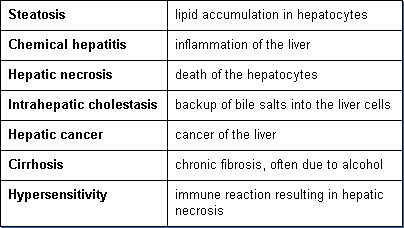|
 |
 |
 |
 |
|
|
|






Organ Specific Toxic Effects

Types of organ specific toxic effects are:
 |
 |
 |
|  | Blood/Cardiovascular Toxicity
|
 |
|  | Dermal/Ocular Toxicity
|
 |
|  | Genetic Toxicity (germ cells)
|
 |
|  | Hepatotoxicity
|
 |
|  | Immunotoxicity
|
 |
|  | Nephrotoxicity
|
 |
|  | Neurotoxicity
|
 |
|  | Reproductive Toxicity
|
 |
|  | Respiratory Toxicity
|
 |
Blood and Cardiovascular Toxicity

Blood and Cardiovascular Toxicity results from xenobiotics acting directly on cells in circulating blood, bone marrow, and heart. Examples of blood and cardiovascular toxicity are:
 |
 |
 |
|  | hypoxia due to carbon monoxide binding of hemoglobin preventing transport of oxygen
|
 |
|  | decrease in circulating leukocytes due to chloramphenicol damage to bone marrow cells
|
 |
|  | leukemia due to benzene damage of bone marrow cells
|
 |
|  | arteriosclerosis due to cholesterol accumulation in arteries and veins
|
 |
Dermal Toxicity

Dermal Toxicity may result from direct contact or internal distribution to the skin. Effects range from mild irritation to severe changes, such as corrosivity, hypersensitivity, and skin cancer. Examples of dermal toxicity are:
 |
 |
 |
|  | dermal irritation due to skin exposure to gasoline
|
 |
|  | dermal corrosion due to skin exposure to sodium hydroxide (lye)
|
 |
|  | dermal hypersensitivity due to skin exposure to poison ivy
|
 |
|  | skin cancer due to ingestion of arsenic or skin exposure to UV light
|
 |
Eye Toxicity

Eye Toxicity results from direct contact or internal distribution to the eye. The cornea and conjunctiva are directly exposed to toxicants. Thus, conjunctivitis and corneal erosion may be observed following occupational exposure to chemicals. Many household items can cause conjunctivitis. Chemicals in the circulatory system can distribute to the eye and cause corneal opacity, cataracts, retinal and optic nerve damage. For example:
 |
 |
 |
|  | acids and strong alkalis may cause severe corneal corrosion
|
 |
|  | corticosteroids may cause cataracts
|
 |
|  | methanol (wood alcohol) may damage the optic nerve
|
 |
Hepatotoxicity

Hepatotoxicity is toxicity to the liver, bile duct, and gall bladder. The liver is particularly susceptible to xenobiotics due to a large blood supply and its role in metabolism. Thus it is exposed to high doses of the toxicant or its toxic metabolites. The primary forms of hepatotoxicity are:

Immunotoxicity

Immunotoxicity is toxicity of the immune system. It can take several forms: hypersensitivity (allergy and autoimmunity), immunodeficiency, and uncontrolled proliferation (leukemia and lymphoma). The normal function of the immune system is to recognize and defend against foreign invaders. This is accomplished by production of cells that engulf and destroy the invaders or by antibodies that inactivate foreign material. Examples are:
 |
 |
 |
|  | contact dermatitis due to exposure to poison ivy
|
 |
|  | systemic lupus erythematosus in workers exposed to hydrazine
|
 |
|  | immunosuppression by cocaine
|
 |
|  | leukemia induced by benzene
|
 |
Nephrotoxicity

The kidney is highly susceptible to toxicants for two reasons. A high volume of blood flows through it and it filtrates large amounts of toxins which can concentrate in the kidney tubules. Nephrotoxicity is toxicity to the kidneys. It can result in systemic toxicity causing:
 |
 |
 |
|  | decreased ability to excrete body wastes
|
 |
|  | inability to maintain body fluid and electrolyte balance
|
 |
|  | decreased synthesis of essential hormones (e.g., erythropoietin)
|
 |
Neurotoxicity

Neurotoxicity represents toxicant damage to cells of the central nervous system (brain and spinal cord) and the peripheral nervous system (nerves outside the CNS). The primary types of neurotoxicity are:
 |
 |
 |
|  | neuronopathies (neuron injury)
|
 |
|  | axonopathies (axon injury)
|
 |
|  | demyelination (loss of axon insulation)
|
 |
|  | interference with neurotransmission
|
 |
Reproductive Toxicity

Reproductive Toxicity involves toxicant damage to either the male or female reproductive system. Toxic effects may cause:
 |
 |
 |
|  | decreased libido and impotence
|
 |
|  | infertility
|
 |
|  | interrupted pregnancy (abortion, fetal death, or premature delivery)
|
 |
|  | infant death or childhood morbidity
|
 |
|  | altered sex ratio and multiple births
|
 |
|  | chromosome abnormalities and birth defects
|
 |
|  | childhood cancer
|
 |
Respiratory Toxicity

Respiratory Toxicity relates to effects on the upper respiratory system (nose, pharynx, larynx, and trachea) and the lower respiratory system (bronchi, bronchioles, and lung alveoli). The primary types of respiratory toxicity are:
 |
 |
 |
|  |
pulmonary irritation
|
 |
|  | asthma/bronchitis
|
 |
|  | reactive airway disease
|
 |
|  | emphysema
|
 |
|  | allergic alveolitis
|
 |
|  | fibrotic lung disease
|
 |
|  | pneumoconiosis
|
 |
|  | lung cancer
|
 |

  
|
|
|
|